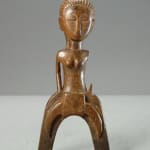Attye Wooden Slingshot, 20th Century CE
Wood
3.125 x 6.75
PF.5892 (LSO)
Further images
This beautifully-patinated catapult was made by one of the tribes of the Lagoons region of the SE Ivory Coast. The area is particularly known for the high degree of refinement...
This beautifully-patinated catapult was made by one of the tribes of the Lagoons region of the SE Ivory Coast. The area is particularly known for the high degree of refinement of its sculptures, and this piece is no exception. It depicts a woman as the handle, her eyes closed under high brows, her hair incised, truncated at the waist and with long, slender arms (the left one broken) resting on each of the catapult’s “arms”. The anterior aspect of the catapult arms is decorated with a pair of sweeping cattle horns; the reverse is plain. Lagoons people are better known for their stools and jewellery than pieces such as this. The patina is golden/brown rather than black, indicating long usage.
The Lagoons people include about a dozen distinct groups, which are grouped into two main units: the Attye and the Ebrie. The Anyi are exactly intermediate between these “classic” Lagoons peoples and their local neighbours, the Baule. Lagoons people are distinct from one another except in cases of threat, when they combine. Their social structure is based upon a gerontocracy. Artistically they are defined by carvings of astonishing refinement, with exceptionally serene expressions and attenuated proportions. They usually have highly ornate hairstyles, keloid scarifications that are rendered as removable plugs, and glossy patinas from usage. The figures were used by spiritual intermediaries to obtain information from the hereafter. There are also reports of highly gendered figures being used as spirit spouses, as in the Baule tradition. They are also said to have been display pieces at traditional dances, or awarded to excellent dancers and performers. They are usually adorned with beads, which are often more diagnostic in terms of area of origin than the piece itself.
Catapults were used by subadult boys to supplement their diets, and were decorated in this manner partly for aesthetic purposes, but also to protect the user and to bless his hunt. This is a beautiful piece of Lagoons material culture, and an attractive sculpture in its own right.
The Lagoons people include about a dozen distinct groups, which are grouped into two main units: the Attye and the Ebrie. The Anyi are exactly intermediate between these “classic” Lagoons peoples and their local neighbours, the Baule. Lagoons people are distinct from one another except in cases of threat, when they combine. Their social structure is based upon a gerontocracy. Artistically they are defined by carvings of astonishing refinement, with exceptionally serene expressions and attenuated proportions. They usually have highly ornate hairstyles, keloid scarifications that are rendered as removable plugs, and glossy patinas from usage. The figures were used by spiritual intermediaries to obtain information from the hereafter. There are also reports of highly gendered figures being used as spirit spouses, as in the Baule tradition. They are also said to have been display pieces at traditional dances, or awarded to excellent dancers and performers. They are usually adorned with beads, which are often more diagnostic in terms of area of origin than the piece itself.
Catapults were used by subadult boys to supplement their diets, and were decorated in this manner partly for aesthetic purposes, but also to protect the user and to bless his hunt. This is a beautiful piece of Lagoons material culture, and an attractive sculpture in its own right.





